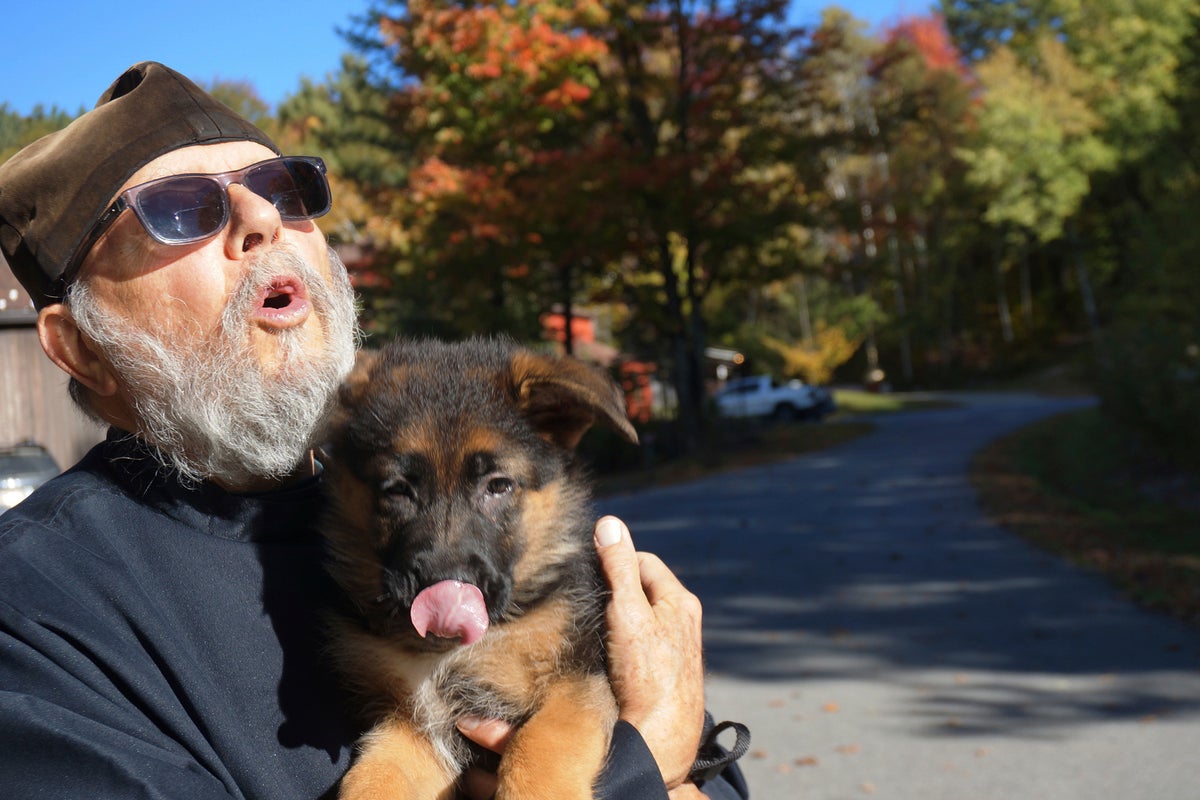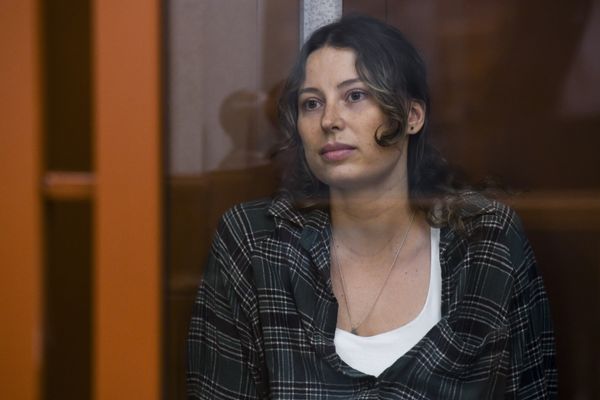
Your support helps us to tell the story
After he and his fellow monks sang morning prayers in their church nestled in a forest, Brother Luke walked back to his residence to be greeted by a different kind of choir.
Lucy and Iso excitedly woofed as they spotted the Orthodox monk, who heads the monastery’s German shepherd breeding program, coming to take them and 10-week-old Pyrena for their morning walks.
For nearly six decades, the monks of New Skete in upstate New York have financially supported their community and deepened their spiritual life by breeding German shepherds and running on-site, weekslong training programs for all kinds of canines.
“One of the things that a dog teaches is about God — forgiveness and love and connection, those are attributes of God,” Brother Luke said on a sunny October morning, while Lucy nosed around fallen leaves and Iso kept a vigilant eye on his monk. “In the rough and tumble of life, we don’t always exhibit God’s love as well as the dog does.”
The New Skete monks' path from Catholic to Orthodox
The small community — today comprising 10 monks and about the same number of adult German shepherds — was started by Franciscan friars who were seeking a more contemplative yet rooted spiritual structure than the Catholic orders were providing them, said Brother Marc. One of the founders — and now 82 — he directs the choir at New Skete together with Brother Luke.
They were inspired by the “explosion of wonderfulness” of the Second Vatican Council to return to ancient but simpler and more accessible practices, like those of the first ascetics in the Egyptian desert, from whom the name skete derives, and who also received pilgrims and performed other community services. The monks officially joined the Orthodox Church in America more than four decades ago; icons of male and female saints from Eastern and Western Christianity adorn the golden walls of the larger of the monastery’s two churches.
By the late 1970s, what had started as a gift of one German shepherd, Kyr, to protect and keep company to the little band of brothers on a forested mountainside where New York and Vermont touch, was revolutionizing their monastic life.
“He became part of the emotional life of the community. All these celibate men living together, where’s the heart in all this?” Brother Marc recalled of Kyr and how his presence brought joy and smoothed over any tensions.
When Kyr died, the monks decided to get more dogs, and to breed them to help sustain the monastery, which like most convents around the world needs to pay for its own upkeep. Then they had to take on training them, so the growing pack could peacefully share the dormitory, refectory and even church with the brothers.
Training for dogs — and humans — starts at the Orthodox monastery
Visitors were impressed by the well-behaved German shepherds and asked the brothers to train their dogs too. One of the early clients turned out to be an editor who encouraged the monks to write about their training philosophy, which was far gentler than the norm at the time.
More than half a dozen widely popular books and a TV series later, the monks today train about 120 dogs a year in the monastery, said Brother Christopher, the prior and director of the training program.
“Training the dogs became for me a means to see more broadly the mystery of God’s presence in creation,” said Brother Christopher, who joined the monastery in 1981. “Dogs are absolutely guileless, they don’t lie. They mirrored me back to myself in a way that was very helpful to my own self-knowledge.”
Building a sustainable relationship between dog and owner, grounded in connection but also structure, is key to the training. Far beyond obedience to basic commands like sit or heel, the pets — and their humans — need to learn the balance of letting dogs be dogs while providing the affection and emotional support their owners seek.
The vast majority of America’s 100 million pet dogs doesn’t need a professional trainer. But many do if their owners want their company in public places or they’re struggling with behaviors ranging from chewing furniture to lunging at the neighbors, said Marc Goldberg, a trainer in Chicago and former president of International Association of Canine Professionals.
The monastery, certified by the association, is the only religious institution among its thousands of members, he added. And while owners of all faiths or none are welcome, the monks infuse their spiritual principles into their relationship with the dogs – in line with a tradition of including animals in spirituality that ranges from Native American practices to the medieval legend of St. Francis taming a wolf that’s portrayed in New Skete’s refectory.
“Monks work very hard but there’s a peacefulness to the life that is palpable,” said Goldberg, who has co-authored several training books with the brothers.
Dog training is expensive – the monks charge about the average for boarding and training, $3,500 for 2.5 weeks, which has become a more reliable source of income than the breeding program. The latter is kept small to give all dogs attention and avoid turning them into a puppy mill, Brother Christopher said.
From dog to God, what the New Skete monks learned through training
Whether in the breeding or the training program, the dogs bring the community closer to God’s creation, encourage paying attention to each present moment, and naturally model Christian virtues, the brothers say.
“A relationship with a dog can sensitize us to a deeper connection with all of creation. That’s humbling,” said Brother Christopher. “We’re simply part of this wondrous world that is ultimately interconnected.”
For Brother Luke, who had never been around dogs before joining the monastery in 1995, the first raucous welcome from the German shepherds jumping out by the dormitory came as a bit of a shock. Today, he’s in awe of witnessing up close “the reality of life,” whether observing the competition in mating season or one of his dogs whelping.
“They’re forgiving, perfectly natural, they are what God created them to be. Those are lessons we could learn,” he said. “Over time, dogs teach us a lot about ourselves. They think we’re better than we are.”
And among all the hard work of keeping up a monastery — hosting visitors, supporting community services like a food pantry in the nearby village of Cambridge, studying Scriptures and intensely praying — the dogs offer simple, nurturing affection.
Most monks keep their dogs in their rooms, so they come back to furiously wagging tails and melting eyes that signal it's the happiest moment of the dog’s day.
“My gosh, that just does something very deep,” Brother Christopher said. “It’s an experience of unconditional love.”







